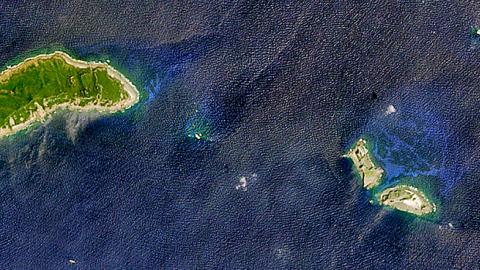Executive Summary
p(firstLetter). Japan’s southwest island chain, an archipelago of 1,200 kilometers (750 miles), is known as the Ryukyu Islands. Along with Taiwan and the Philippines, it comprises what the People’s Republic of China (PRC) perceives as the first of three strategic island chains. To China, these island chains represent geostrategic impediments to Pacific Ocean expansion and power projection, which its adversaries—including the United States and Japan—might use to counter Chinese aggression in a conflict. In particular, the first island chain represents the first geostrategic hurdle for the Chinese People’s Liberation Army Navy (PLAN) as it seeks access to sea lanes in the Pacific and Indian Oceans. Two of China’s three PLAN fleet bases are located on the East China Sea. To reach the South China Sea and the Pacific, ships or aircraft from these bases must transit through the choke points of the Taiwan or Miyako Straits, the latter passage through the Ryukyus. Japan’s southwest islands pose a significant strategic and operational challenge for China, and thus their defense is equally strategically and operationally important for Japan.
China, to achieve its goal of global superpower status by the mid-twenty-first century, has sought to contest and change the status quo across the Indo-Pacific region by constructing and arming islands from the South China Sea to the East China Sea and beyond. As part of this effort, the PRC has expanded and modernized its armed forces. The immediate objective is to neutralize what Chinese rulers regard as the threat of the first island chain. This has included building a larger and more advanced surface fleet and air force, including the country’s first aircraft carrier, as well as advanced destroyers and more advanced aircraft. It also involves developing and expanding China’s amphibious assault capabilities by means of a larger and more capable PLAN Marine Corps, along with more amphibious warships, amphibious aircraft, and amphibious assault vehicles. In the PRC’s crosshairs is not only Taiwan, the keystone of the first island chain and a vigorous democracy, but also the Senkaku Islands of Japan, whose sovereignty the PRC contests, and the Ryukyu Islands. Any Chinese invasion of Taiwan or military attempt to assert sovereignty over the Senkaku Islands runs the risk of drawing the United States and Japan into a conflict with the PRC.
The U.S.-Japan alliance obliges the United States to defend Japan and its sovereign islands. Both countries maintain a security presence in the Ryukyus, principally on the island of Okinawa, where the U.S. Marine Corps (USMC) maintains a nineteen-thousand-strong force, alongside U.S. Air Force, Army, and Navy units. The Japanese Self-Defense Forces (JSDF) and Coast Guard also maintain ground, maritime, and aviation elements on Okinawa and conduct regular air and sea patrols throughout Japan’s southwest islands. In keeping with constitutional restrictions that limit Japan’s security forces to self-defense, Japan’s Ministry of Defense has also recently sought to bolster the country’s amphibious capabilities to counter potential Chinese aggression.
In the face of a rising PRC challenge, the United States and Japan have in recent years streamlined and strengthened their security cooperation. This has included participation in bilateral and multilateral exercises to improve interoperability at tactical and operational levels. In addition, the 2015 creation of an alliance coordination mechanism (ACM) provides guidelines for the U.S. and Japanese governments to coordinate defense cooperation, including the defense of Japan’s outlying islands, at a policy level. However, the two countries still lack an integrated means—at the bilateral or multilateral level—to coordinate operations in response to regional contingencies.
Summary of Recommendations
To strengthen the defense of Japan’s southwest islands, Japan and the United States should improve both strategic and operational-level engagement and coordination. This requires direct discussions between the two countries’ policymakers to create a bilateral strategy for a conflict over Taiwan or the Japanese islands themselves. This should also involve joint tabletop exercises (TTX)—simulations that examine crises and review possible responses—and operational-level exercises, expansion of defensive capabilities for Japan’s outlying islands, and upgrading of operational-level command and control for the southwest islands. The two countries should seek to forge closer ties and integrated defense capabilities in the region to deter PRC aggression and maintain a stable, viable status quo.
Strategic Level
Initiate U.S.-Japan Engagement and Policy Planning
The U.S. and Japan should build a multifaceted strategy to deter or counter Chinese actions against Taiwan, the Senkakus, or even the Ryukyus. Planning will have to take into account the constitutional constraints on the JSDF and establish strategic roles for both countries in advance of crises in and around Japan’s southwest islands. This includes guarantees and support for free and open sea lines of communication (SLOCs) should an attack occur against Taiwan or Japan, and bilateral mobilization in the political arena to isolate China.
Operational Level
Conduct Bilateral Planning and Exercises
The U.S. and Japan should hold high-level dialogues to examine possible PLAN operations and explore how to counter Chinese actions at an operational level—from island defense and amphibious assault, to engaging and defending against Chinese cyber activities that support conventional operations.
Expand Joint Island-Defense Capabilities
To provide island defense, the U.S. and Japan should also establish closer operational-level coordination between the JSDF, including its Coast Guard, and the U.S. military. Measures should include improving intelligence, sharing real-time surveillance, and undertaking reconnaissance (ISR). In addition, the U.S. Marine Corps and Japan’s new amphibious brigades should build joint amphibious rapid-reaction capabilities to defend or retake outlying islands.
Establish Japan’s Defensive Support Role for the U.S. in a Regional Contingency
The United States could be drawn into a conflict with China as the result of a Chinese attempt to use force against Taiwan. There are ways that Japan could support U.S. activities without violating its constitutional restrictions. One would be to provide non-military assistance, such as search and rescue (SAR) for U.S. forces in theater. Another would be to direct Japan’s Coast Guard and the JSDF to secure U.S. installations in Japanese territory, particularly Okinawa, from Chinese attacks.
The Japanese Ministry of Defense and the JSDF have developed or are developing unique and valuable defense technologies and equipment capable of supporting remote island defense and SAR operations. These amphibious platforms and technologies should be provided to the United States military—and the USMC especially—to bolster American operations in the region.
Build Operational Command and Control for the Southwest Islands
At an operational level, the U.S. and Japan should aim to build more integrated command-and- control structures for the Japanese southwest islands, beyond the slow-moving, policy-level coordination of the alliance coordination mechanism (ACM). To counter any weakness that the PRC could exploit against the islands, the U.S. and Japan should formalize ties between their forces in theater, through liaisons in their headquarters and on warships, and through planning cycles. This would enable them to exchange best practices and familiarize themselves with the other side’s operations. The goal of these activities would be to establish regional command and control under a Combined Joint Command Center that could be fully activated immediately in a crisis and allow for swifter joint decision-making.





















